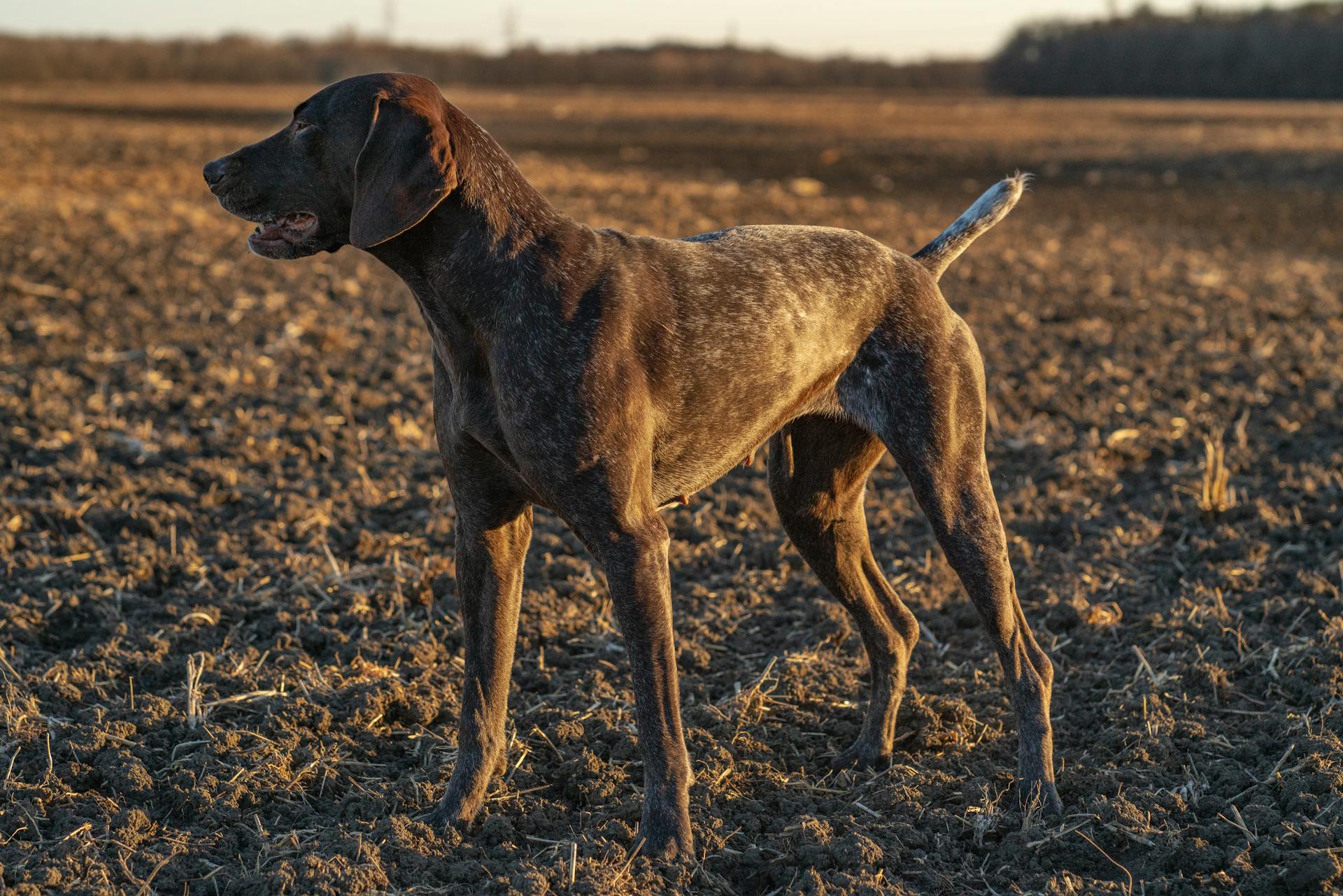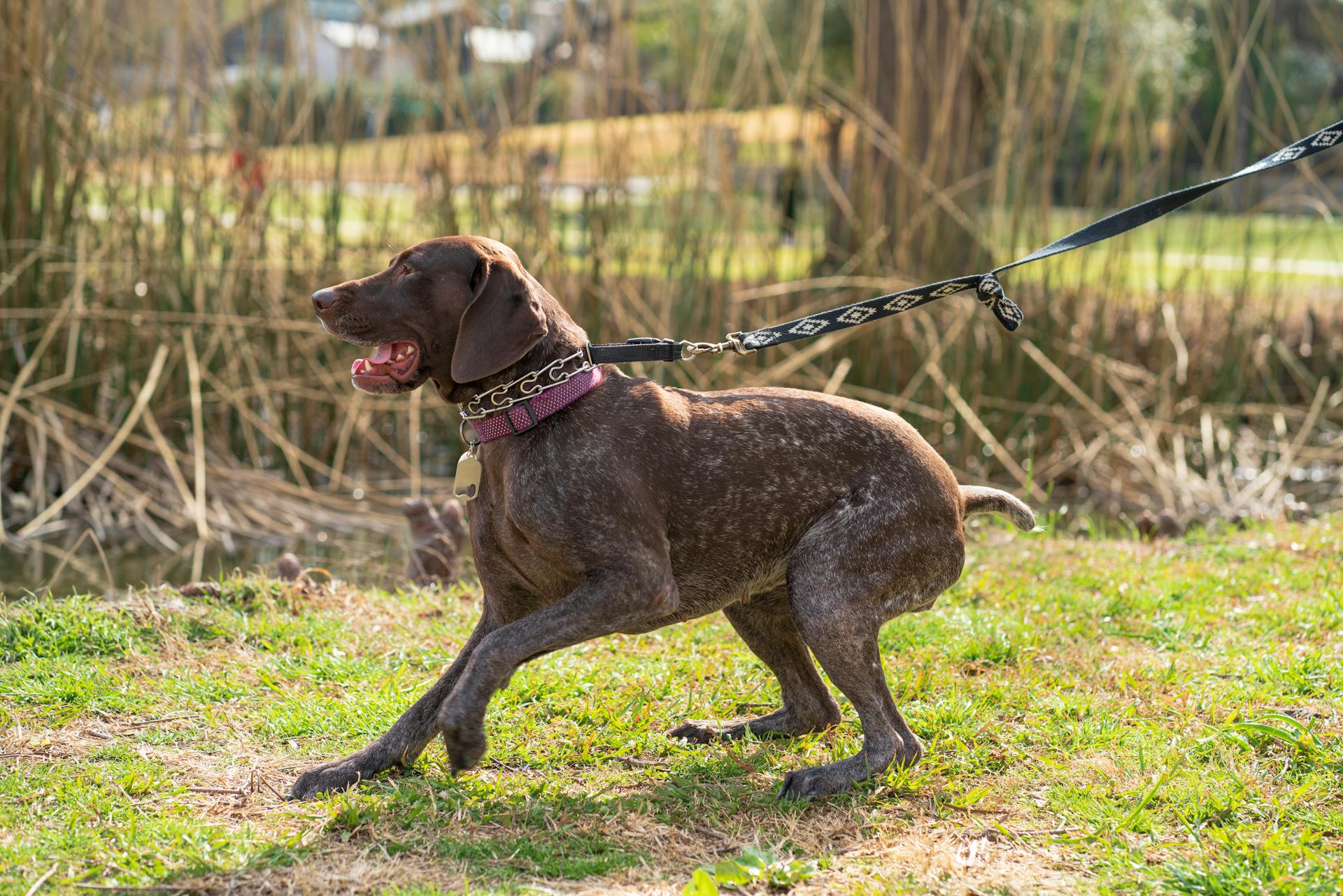
The Liver German Shorthaired Pointer is a versatile hunting dog with a rich history dating back to the 19th century.
Originating in Germany, this breed was developed to excel in multiple hunting disciplines, including waterfowl, upland game, and tracking.
Their distinctive liver-colored coat is a result of a genetic variation that affects the production of eumelanin, the pigment responsible for black and dark brown colors.
Their short, dense coat requires minimal grooming, making them a great choice for busy owners.
Size and Physical Characteristics
The Liver German Shorthaired Pointer is a medium-sized breed.
Males typically stand 23 to 25 inches tall at the shoulder.
Females have a slightly smaller stature, standing 21 to 23 inches tall at the shoulder.
Their weight range is relatively consistent, with males weighing between 55 to 70 pounds and females weighing around 45 to 60 pounds.
Size
The German Shorthaired Pointer is a medium to large-sized breed.
Males typically stand 23 to 25 inches tall at the shoulder, with a weight range of 55 to 70 pounds.
Females have a slightly smaller stature, standing 21 to 23 inches tall at the shoulder.
Their weight range is around 45 to 60 pounds.
Coat Color and Grooming
The German Shorthaired Pointer's coat is a standout feature of the breed. It's short and dense, providing excellent water resistance.
The coat is slightly longer on the underside of the tail and the back edges of the rear end, known as the haunches. This is a common observation in many GSPs.
The coat comes in a variety of colors and patterns, including solid liver, liver with white markings, ticking, patches of liver color, and roan. These colors can create a rich and unique appearance.
Regular brushing with a firm bristle brush once a week is sufficient to keep the coat in good condition. This is a great habit to get into, especially during shedding season.
The GSP's smooth and short coat is relatively low maintenance and doesn't shed excessively. This makes them a great choice for busy owners.
Bathing should be done only when necessary, as over-bathing can strip the coat of its natural oils. A gentle towel or chamois rub can help enhance the coat's shine.

It's essential to pay attention to your GSP's feet, particularly after exercise or field work. Check for any foreign objects or signs of irritation and ensure they are thoroughly dry to prevent discomfort or potential issues.
Regularly examining your GSP's ears for signs of infection, such as a foul odor, redness, or tenderness, is crucial. If your GSP frequently scratches at his ears, it may indicate an underlying infection that requires veterinary attention.
Personality and Temperament
The liver German Shorthaired Pointer is known for its intelligence and eagerness to please. They approach everything with enthusiasm, displaying a confident and steady demeanor.
They form strong bonds with everyone in the family, but may have a special favorite member. This breed thrives as house dogs, valuing close companionship rather than being kept in a yard or kennel.
Their high trainability is one of their most remarkable qualities, making them receptive to learning and enjoy the mental stimulation that training provides. Early socialization is crucial for them, exposing them to a wide range of people, sights, sounds, and experiences.
They can develop separation anxiety if left alone, so it's essential to provide them with plenty of attention and interaction. Meeting the parents, especially the mother, can give you an idea of their temperament and help you choose a puppy with a nice temperament.
Regular exercise and consistent training are a must for liver German Shorthaired Pointers, as they can become destructive without it. They are loving, protective, energetic, and playful dogs, making them amazing pets for active owners.
Health and Care
German Shorthaired Pointers are generally a healthy breed, but like all dogs, they're prone to certain health conditions. Hip dysplasia is a condition in which the hip joint doesn't develop properly, ranging from mild to severe cases that may require surgical intervention.
Regular veterinary check-ups and proper diet can help prevent or manage these conditions. Clearances from the Orthopedic Foundation for Animals (OFA) and the Canine Eye Registry Foundation (CERF) are essential when purchasing a GSP puppy.
Adequate exercise is crucial for German Shorthaired Pointers, with at least an hour of physical activity required each day to prevent nervousness and destructive behaviors. Engage them in strenuous hikes, long walks, and energetic games of fetch to keep them happy and healthy.
For another approach, see: Bernese Mountain Dog Hip Dysplasia
Health

German Shorthaired Pointers are generally a healthy breed, but like all dogs, they can be prone to certain health conditions. Hip dysplasia is a condition where the hip joint doesn't develop properly, ranging from mild to severe cases. Dogs with hip dysplasia should not be used for breeding.
Cancer is a concern for GSPs, with a higher incidence of mammary tumors, mast cell tumors, and lymphosarcoma. Regular veterinary check-ups can help detect these conditions early on.
Von Willebrand's disease is a blood disorder that affects the clotting process, causing symptoms like nosebleeds, bleeding gums, and prolonged bleeding after surgery. It's a manageable condition with proper treatment.
Gastric dilatation-volvulus (GDV), also known as bloat or torsion, is a life-threatening condition that can occur in deep-chested breeds like GSPs. Immediate veterinary attention is necessary to prevent severe complications.
Proper diet, exercise, and regular vet check-ups can help prevent or manage these health conditions in GSPs.
Care
German Shorthaired Pointers need a lot of exercise, at least an hour a day, to stay happy and healthy. They love going on strenuous hikes, long walks, and playing energetic games of fetch.
If you don't have a secure, high fence in your yard, a German Shorthaired Pointer might not be the best fit for you. They're bred to be active and love to explore.
Crate training is a good idea for young GSPs, especially when you're not around to supervise. It'll help prevent mischief and keep them safe.
Training a German Shorthaired Pointer requires kindness, consistency, and positive reinforcement. Harsh treatment will only make them more stubborn.
You should brush your GSP's coat once a week with a firm bristle brush. Regular bathing is not necessary, but it's a good idea to keep an eye out for any foreign objects or signs of irritation on their feet.
Checking your GSP's ears regularly is important to prevent infections. If you notice any foul odors, redness, or tenderness, it's time to visit the vet.
Nutrition and Feeding
A balanced diet is essential for your liver German Shorthaired Pointer. Large breed dogs, including German Shorthaired Pointers, benefit from a different balance of nutrients including minerals and vitamins compared to smaller-breed dogs.
To ensure your GSP gets the right nutrients, you'll want to feed a high-quality dry food. A recommended daily amount is 2 to 3 cups, divided into two meals.
The quality of the dog food you choose plays a significant role in nourishing your GSP. Higher-quality dog food provides better nutrition, allowing you to feed smaller portions while meeting their nutritional requirements.
Just like people, dogs are individuals with unique dietary needs. A highly active GSP will naturally require more food compared to a less active couch potato dog.
Family Suitability
German Shorthaired Pointers are a great fit for active families with older kids who enjoy physical activity. They have the energy to match their children's playfulness and can help wear each other out.
However, their boisterous nature may be too much for small children, and they require close supervision when interacting with toddlers and younger kids. It's essential to educate children on how to approach and handle dogs gently and respectfully.
GSPs generally get along with other dogs, but early socialization is crucial to prevent aggression towards dogs of the same sex. They may also display aggression towards small animals like cats or rabbits due to their hunting instincts.
To ensure a harmonious household, it's vital to provide a safe outdoor space for your GSP to run around, as they require regular exercise to burn off energy. Without access to a fenced yard or outdoor space, it can be challenging to provide enough exercise for your dog.
As with any dog, it's essential to supervise interactions between your GSP and other pets, especially if they're not familiar with each other. With patience, proper training, and socialization, your GSP can live harmoniously with other animals in the household.
A fresh viewpoint: How Much Exercise Do Labrador Retrievers Need
Training and Exercise
German Shorthaired Pointers are intelligent and love working with their owners, making them easy to train to a high standard. They excel in pet gun dog classes, which provide an outlet for their natural hunting behaviors.
To keep your German Shorthaired Pointer fit and happy, they need at least 1-2 hours of exercise daily. Long walks, jogs, hikes, or running off-leash in a safe area are great options.
Training
Training your German Shorthaired Pointer requires patience and the right approach. They thrive on mental and physical stimulation, so a high standard of training is achievable with the right guidance.
German Shorthaired Pointers are intelligent and clever dogs who love working with their owners. This makes them highly responsive to training.
To unlock their full potential, find pet gun dog classes that cater to their natural hunting behaviors. These classes provide an outlet for their hardwired instincts, keeping them happy and engaged.
With consistent training and the right outlet for their energy, German Shorthaired Pointers can excel in various roles, including hunting and working with their owners.
On a similar theme: Are German Shepherds Good for First Time Owners
Exercise

Exercise is a must for German Shorthaired Pointers, and they need at least 1-2 hours of it daily.
Strolling around the neighborhood just won't cut it - they need long walks, jogs, hikes, or running off-leash in a safe area to keep them happy and fit.
German Shorthaired Pointers are true athletes who love agility, field trials, dock diving, and tracking competitions.
If they don't have a healthy outlet for their energy, they'll get bored and frustrated, leading to destructive behaviors.
Meeting their daily exercise demands is a big commitment, but it's essential for their well-being.
General Information
The Liver German Shorthaired Pointer is a versatile hunting breed that originated in Germany. They are a medium-sized dog with a muscular build.
Their distinctive liver-colored coat is a result of a genetic variation that affects the production of the pigment phaeomelanin. This coloration is a key characteristic of the breed.
In terms of temperament, Liver German Shorthaired Pointers are known for being energetic and outgoing.
History and Origins

The German Shorthaired Pointer has a rich history that spans centuries. The breed was created in Germany in the 17th century.
The first attempts to breed the German Shorthaired Pointer involved crossing the Spanish Pointer with early German bird dog breeds and possibly the Bloodhound. However, this resulted in a heavy and slow dog.
It took centuries to develop the modern German Shorthaired Pointer. The breed has undergone significant changes over time to become the versatile hunting dog we know today.
The German Shorthaired Pointer's development involved crossing breeds such as the Spanish Pointer, Hannover Hound, and English Pointer. These breeds all contributed to the breed's distinctive characteristics.
The breed's early development was focused on improving its searching ability rather than speed. This emphasis on versatility has made the German Shorthaired Pointer a popular choice for hunters and outdoor enthusiasts.
The German Shorthaired Pointer was first introduced to the United States in the 1920s.
Quick Facts

The German Shorthaired Pointer is a breed that's full of energy and enthusiasm. Originating from Germany, this sporting dog is built for action.
Here are some key stats about the German Shorthaired Pointer:
- Height: 22-25 inches (male), 21-23 inches (female)
- Weight: 55-70 pounds (male), 45-60 pounds (female)
- Lifespan: 12-14 years
- Exercise requirements: High
- Grooming needs: Moderate
With their high energy levels, German Shorthaired Pointers need plenty of exercise to stay happy and healthy. They're also known for being friendly, intelligent, and eager to please, making them a great breed for active families.
Three Little-Known Facts
Did you know that the average person spends around 90% of their time indoors? This is a staggering statistic, especially considering the importance of getting enough fresh air and natural light.
The human eye can detect an incredible 10 million different colors, but did you know that the color blue is actually the most difficult for the human eye to perceive?
It's worth noting that the Earth's atmosphere scatters shorter wavelengths of light, such as blue and violet, more than longer wavelengths, like red and orange. This is why the sky often appears blue during the day.
Here's an interesting read: Red Wheaten Rhodesian Ridgeback
Frequently Asked Questions
What is the leading cause of death in German Shorthaired Pointers?
The leading cause of death in German Shorthaired Pointers is cancer, particularly in their golden years. Knowing the risks can help you and your veterinarian take proactive steps to ensure your pet's health and well-being.
What color is a pointer dog liver?
A German Shorthaired Pointer's "liver" color is a brown with a reddish tint, ranging from dark to light shades. This unique color can appear nearly black or milk chocolate-like.
What is the best dog food for German Shorthaired Pointers?
For German Shorthaired Pointers, consider Hills Science Diet Large Breed or Royal Canin Maxi Adult, as they cater to the breed's specific needs and life stage. Both options provide tailored nutrition for optimal health and energy.
What is the digestive problem with German Shorthaired Pointers?
German Shorthaired Pointers are prone to bloat, a life-threatening digestive disorder also known as gastric dilatation and volvulus (GDV). This condition can be a serious concern for GSP owners due to their deep-chested breed characteristics.
What is the life expectancy of a German Shorthaired Pointer?
A German Shorthaired Pointer's average lifespan is 12-14 years. Factors such as diet, exercise, and living environment can influence their individual life expectancy.
Sources
- https://dogtime.com/dog-breeds/german-shorthaired-pointer
- https://www.akc.org/expert-advice/dog-breeds/german-shorthaired-pointer-history/
- https://www.purina.co.uk/find-a-pet/dog-breeds/german-short-haired-pointer
- https://www.dogster.com/dog-breeds/german-shorthaired-pointer
- https://www.dogbreedinfo.com/germanshorthairedpointer.htm
Featured Images: pexels.com


